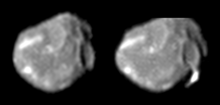Wikijunior:Solar System/Jupiter/Amalthea

Amalthea Facts:
- Amalthea is the reddest object in the Solar System, even redder than Mars.
- Before 1975, Amalthea was not considered the official name (though it had extensive informal use) of the moon. Prior to the current name, it was called Jupiter V.

Amalthea is the third moon of Jupiter. Amalthea's oribt is very close to the Amalthea gossamer ring.
How big is Amalthea?
[edit | edit source]Amalthea is not spherical like a ball, instead it looks like an asteroid. In fact, there is an asteroid in the asteroid belt named 113 Amalthea. However, the asteroid is completely unrelated to the moon. This moon of Jupiter has an average diameter of 172 km. The entire moon is actually a bit smaller than Ireland.
What is its surface like?
[edit | edit source]The surface of Amalthea is bright crimson. The reddish colour may be from sulfur or some other non-ice material. Amalthea has multiple craters, but only two are named: Pan, named after the Greek god of the wild; and Gaia, goddess of the Earth. Amalthea also has two named mountains, both named after places in Crete, the largest island of Greece: Lyctos Facula, named after Lyctos; and Ida Facula, named after Mount Ida. Facula, in Latin, means a small torch.
How long is a day on Amalthea?
[edit | edit source]One day on Amalthea is equal to about half of an Earth day. One day is 11 hours, 57 minutes, and 23 seconds, barely more time than Jupiter takes to rotate.
How long is its orbit around Jupiter?
[edit | edit source]One orbit around Jupiter also takes the same time as a day on Amalthea — about half of an Earth day. Since these two times are the same, the same side of Amalthea always faces Jupiter. Earth's moon is the same way, which is why you can always see the Man in the Moon.
How would Amalthea's gravity pull on me?
[edit | edit source]If you stood on the surface of Amalthea, you would weigh only 1/555 of what you do on Earth. A one hundred pound person would weigh only 0.18 pounds on Amalthea, which is a little more than ten 50p, or 14 quarters! This means that if you could lift ten kilograms on earth, you could hold three cars on Amalthea. The strongest weightlifter would be able to lift a blue whale, the heaviest animal on Earth.
Who is it named after?
[edit | edit source]Amalthea (Greek Ἀμάλθεια) is named after a nymph in Greek myths who nursed Zeus, which is the Greek counterpart of the god Jupiter, with goat's milk.
How was it discovered?
[edit | edit source]
Amalthea was discovered on September 22, 1892 by Edward Emerson Barnard, using the 36 inch (91 cm) refractor telescope at Lick Observatory, in California. He was the first to discover a new moon of Jupiter since Galileo discovered Io and Europa in 1610.
